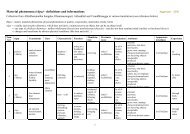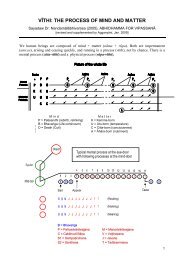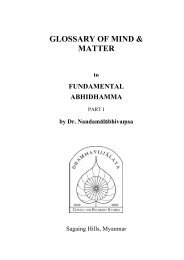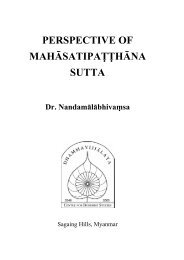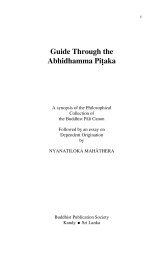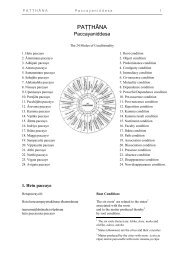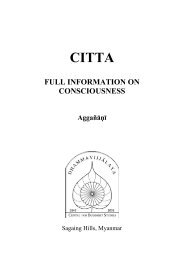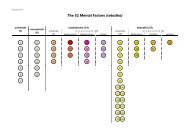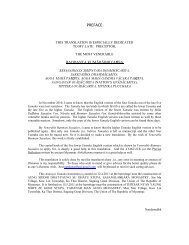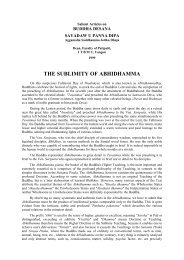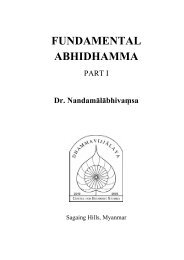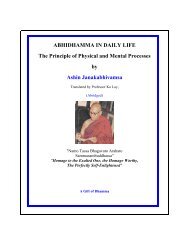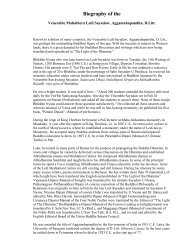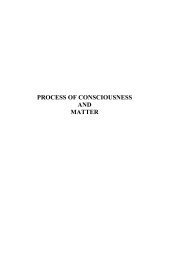Paṭṭhāna - Sahajāta-group - Abhidhamma.com
Paṭṭhāna - Sahajāta-group - Abhidhamma.com
Paṭṭhāna - Sahajāta-group - Abhidhamma.com
Create successful ePaper yourself
Turn your PDF publications into a flip-book with our unique Google optimized e-Paper software.
A g g a n y ā n i P A Ṭ Ṭ H Ā N A 20<br />
PAṬṬHĀNA<br />
Conditional Relations<br />
<strong>Sahajāta</strong> <strong>group</strong> – Conascence-<strong>group</strong><br />
The 24 conditions (paccayas)<br />
The sahajāta-<strong>group</strong> is marked in yellow
A g g a n y ā n i P A Ṭ Ṭ H Ā N A 21<br />
<strong>Sahajāta</strong> <strong>group</strong> – Conascence-<strong>group</strong><br />
Conditions or forces of this <strong>group</strong> are working together because of conascence, meaning they are born<br />
together. One phenomenon arising and existing together with other phenomena is influencing,<br />
“colouring” and supporting these other conascent phenomena; but it cannot produce them.<br />
There are 15 conditioning forces which can work together in this <strong>group</strong> (but never all 15 together,<br />
because some of them exclude each other):<br />
1. Hetu paccaya Root condition<br />
2. Adhipati paccaya (sahajāta-) Predominance (only conascence-predominance)<br />
3. <strong>Sahajāta</strong> paccaya Conascence condition<br />
4. Aññamañña paccaya Mutuality condition<br />
5. Nissaya paccaya (sahajāta-) Support (only conascence-support)<br />
6. Kamma paccaya (sahajāta-) Kamma condition (only conascent kamma)<br />
7. Vipāka paccaya Result condition<br />
8. Āhāra paccaya Nutriment condition<br />
9. Indriya paccaya (sahajāta-) Faculty condition (only conascent faculty)<br />
10. Jhāna paccaya Jhāna condition<br />
11. Magga paccaya Path condition<br />
12. Sampayutta paccaya Association condition<br />
13. Vippayutta paccaya (sahajāta-) Dissociation (only conascence-dissociation)<br />
14. Atthi paccaya (sahajāta-) Presence (only conascence presence)<br />
15. Avigata paccaya (sahajāta-) Non-disappearance (only conascence ~)<br />
According to their nature and appearance the conascence-<strong>group</strong> can be divided into three sub<strong>group</strong>s,<br />
big, medium and small. We want to re-enumerate the 15 conditions accordingly and explain them in<br />
this order:<br />
1. The “big” or “senior” sahajāta-<strong>group</strong> – four conditions which are present always:<br />
1. <strong>Sahajāta</strong> paccaya Conascence condition<br />
2. Nissaya paccaya (sahajāta-) Support (only conascence-support) condition<br />
3. Atthi paccaya (sahajāta-) Presence (only conascence presence) condition<br />
4. Avigata paccaya (sahajāta-) Non-disappearance (only conascence ~) condition
A g g a n y ā n i P A Ṭ Ṭ H Ā N A 22<br />
2. The “medium” sahajāta-<strong>group</strong> – four conditions included quite often but not always:<br />
5. Aññamañña paccaya Mutuality condition<br />
6. Vipāka paccaya Result condition<br />
7. Sampayutta paccaya Association condition<br />
8. Vippayutta paccaya (sahajāta-) Dissociation (only conascence-dissociation) condition<br />
3. The “small” or “junior” sahajāta-<strong>group</strong> – seven conditions included occasionally:<br />
9. Hetu paccaya Root condition<br />
10. Adhipati paccaya (sahajāta-) Predominance (only conascence-predominance) condition<br />
11. Āhāra paccaya Nutriment condition<br />
12. Kamma paccaya (sahajāta-) Kamma condition (only conascent kamma)<br />
13. Indriya paccaya (sahajāta-) Faculty condition (only conascent faculty)<br />
14. Jhāna paccaya Jhāna condition<br />
15. Magga paccaya Path condition<br />
Big <strong>Sahajāta</strong>-<strong>group</strong><br />
The members of the big conascence <strong>group</strong> are always present; that means, these four conditional<br />
relations are always involved whenever phenomena are born together.<br />
1. <strong>Sahajāta</strong> paccaya – conascence condition<br />
This is the main condition in this <strong>group</strong>. “Saha-jāta” means born together, indicating that cause and<br />
effect arise at the same time. The effect is supported, not produced. Especially when we consider one<br />
unit of either mind or matter, the conascence condition is important, because within this unit the<br />
conditioning and the conditioned phenomena arise together, co-exist, and disappear together.<br />
There are different ways of enumeration. We can distinguish for example:<br />
1. Within any unit of mind consciousness (citta) and its mental factors (cetasikas) are born<br />
together. They arise together and perish together and support each other. This is the case for<br />
all 89 cittas and all 52 cetasikas.<br />
2. Additionally in the five-aggregate-planes, during the life (pavatti) consciousness-born matter<br />
(cittaja rūpa) is also born together with the arising (“birth”) of the consciousness. At rebirth<br />
(paṭisandhi) kamma-born matter (kammaja rūpa) is born together with the arising of the<br />
paṭisandhi-citta.<br />
3. In any unit of matter (rūpa) the four great elements (mahābhūtas) and depending matters<br />
(upādāya rūpas) are born together and support each other.<br />
4. At the rebirth-moment (paṭisandhi) in the five-aggregate-planes, the four mental aggregates<br />
(khandhā) are born together with the heart-base (hadaya-vatthu) and support each other. In<br />
other words: At rebirth, the 15 paṭisandhi-cittas and associated cetasikas arise together and<br />
depending on the heart-base – and vice versa.<br />
Generally: conditioning conditioned<br />
89 cittas<br />
52 cetasikas<br />
cittaja rūpa<br />
kammaja rūpa<br />
4 mahābhūta<br />
24 upādā -rūpa<br />
citta + cetasikas<br />
hadaya-vatthu<br />
sahajāta paccaya<br />
52 cetasikas<br />
89 cittas<br />
cittaja rūpa<br />
kammaja rūpa<br />
24 upādā-rūpa<br />
4 mahābhūta<br />
hadaya-vatthu<br />
citta + cetasikas
A g g a n y ā n i P A Ṭ Ṭ H Ā N A 23<br />
The sahajāta-condition is very wide: Mind conditions mind (No.1). Mind conditions mind + matter<br />
(No. 2). Mind conditions matter (No. 4). Matter conditions matter (No. 3). Matter conditions mind<br />
(No. 4 vice versa).<br />
Examples:<br />
For (1):<br />
1. The first dosamūla citta is conditioning or influencing all the 20 associated mental factors<br />
(cetasikas) which are born together with it. So, for example, concentration (samādhi that is the<br />
universal cetasika ekaggatā) born together with the dosamūla citta be<strong>com</strong>es unwholesome;<br />
associated energy or effort (vīriya) also be<strong>com</strong>es unwholesome or even dangerous; feeling<br />
(vedanā) be<strong>com</strong>es unpleasant, unhappy, mentally painful – effects through the power of the<br />
sahajāta condition.<br />
2. If in a meditator, mindfulness (sati) is well developed through Vipassanā-practice, what will it<br />
condition in the mind by the force of sahajāta paccaya? It is conditioning the respective<br />
consciousness, one of the eight great wholesome types of consciousness (mahākusala cittas),<br />
and the other mental factors (maximum 37 cetasikas). For example, conascent concentration is<br />
conditioned to be wholesome and might reach up to access-concentration (upacāra-samādhi)<br />
or concentration from moment to moment (kaṇika-samādhi) supported by our sati.<br />
For (2):<br />
1. Craving (lobha) is not only conditioning the conascent lobhamūla citta and the other<br />
maximum 20 cetasikas, but at its arising moment consciousness-born matters (cittaja rūpas)<br />
too. For example if saliva flows together in our mouth because of our greed for a certain food,<br />
that saliva is citta-born matter with excess of water-element (āpo).<br />
2. At the moment of rebirth (paṭisandhi) as a human being, the respective great resultant<br />
consciousness (one of eight mahāvipāka cittas) is conditioning its associated maximum 33<br />
cetasikas and also the first kamma-born matter (kammaja rūpa) at the very time it arises.<br />
These first kamma-born matters are the 10 rūpas of the body-sensitivity-<strong>group</strong> (kāya-pasāda<br />
kalāpa), the 10 rūpas of the heart-base-<strong>group</strong> (hadayavatthu kalāpa), and the 10 rūpas of the<br />
sex-<strong>group</strong> (bhāva-kalāpa).<br />
For (3):<br />
The earth-element (paṭhavī-dhātu) is conditioning the other three great elements (mahābhūtas),<br />
namely the water-, fire- and air-element (āpo-, tejo-, vāyo-dhātu) the very moment when it itself is<br />
born. And also it is conditioning the derivative matters (upādā-rūpas) like colour, smell, etc.<br />
For (4):<br />
At the rebirth-moment (paṭhisandhi) of a dog, its rebirth-consciousness – which is investigating<br />
consciousness with neutral feeling resultant of unwholesome kamma (akusala-vipāka upekkhāsantīraṇa)<br />
– conditions its 10 associated cetasikas and simultaneously the kamma-born heart-base<br />
(hadaya-vatthu) on which they are arising.<br />
In the Visuddhimagga we read [chapter XVII, 535, in Pe Maung Tin’s translation]:<br />
<br />
A state which is about to arise and which renders service by being together with the<br />
arising co-existent cause, like the lamp and the lamp-light.<br />
It is of six kinds by way of the immaterial aggregates, etc. As it has been said: “The four immaterial<br />
aggregates are in co-existent causal relation to one another. So are the four great primaries to one<br />
another, name and form 1 at the moment of descent at birth, states of mind and mental properties to<br />
material states originating from mind, the great primaries to derived material things, material states<br />
sometimes are, sometimes are not in co-existent causal relation to non-material states.” This (clause) is<br />
said concerning the heart-basis.<br />
1 in Pāḷi “nāma + rūpa”: Mind + matter, or mentality + corporeality
A g g a n y ā n i P A Ṭ Ṭ H Ā N A 24<br />
Paccayaniddesa: <strong>Sahajāta</strong> paccayo<br />
<strong>Sahajāta</strong>paccayo'ti:<br />
1. Cattāro khandhā arūpino aññamaññaṃ<br />
sahajāta paccayena paccayo.<br />
2. Cattāro mahābhūtā aññamaññaṃ<br />
sahajāta paccayena paccayo.<br />
3. Okkantikkhaṇe nāmarūpaṃ aññamaññaṃ<br />
sahajāta paccayena paccayo.<br />
4. Cittacetasikā dhammā cittasamuṭṭhānānaṃ<br />
rūpānaṃ sahajāta paccayena paccayo.<br />
5. Mahābhūtā upādārūpānaṃ<br />
sahajāta paccayena paccayo.<br />
6. Rūpino dhammā arūpinaṃ dhammānaṃ<br />
kiñci kāle sahajāta paccayena paccayo.<br />
Kiñci kāle na sahajāta paccayena paccayo.<br />
2. Nissaya paccaya – support condition<br />
Co-nascence Condition:<br />
The four immaterial aggregates 2 are mutually<br />
related to one another by co-nascence condition.<br />
The four great essentials 3 are mutually related to<br />
one another by co-nascence condition.<br />
At the moment of conception, mind 4 and matter 5<br />
are mutually related to each other by co-nascence<br />
condition<br />
Consciousness and mental factors are related to<br />
mind-produced matter by co-nascence condition.<br />
The great essentials are related to derived matter<br />
by co-nascence condition.<br />
Material phenomena are sometimes 6 related to<br />
immaterial (i.e. mental) phenomena by conascence<br />
condition.<br />
Sometimes 7 they are not related by co-nascence<br />
condition.<br />
2 These are the mental aggregates: vedanā-, saññā-,<br />
saṅkhāra- and viññāṇakkhandha<br />
3 or four great elements (mahābhūta): Earth-, water-,<br />
fire- and air-element<br />
4 Here mind refers to paṭisandhi-citta + its<br />
associated cetasikas<br />
5 Here only 30 kamma-born matter, namely the<br />
three kammaja kalāpas: heartbase-decad, bodysensitivity-decad<br />
and sex-decad<br />
6 at the moment of conception (okkantikkhaṇe) or<br />
rebirth (paṭisandhi) – see No. 3<br />
7 during life-time (pavatti)<br />
A conditioned effect arises dependent on or with the support of the conditioning state by the force of<br />
nisssaya. There are two kinds of support, conascence (sahajāta) and prenascence (purejāta) support.<br />
Here in the sahajāta-<strong>group</strong> we deal with conascence support (sahajāta nissaya) only.<br />
Conascence support is totally the same as conascence (sahajāta).<br />
In the Visuddhimagga we read [chapter XVII, 535, in Pe Maung Tin’s translation]:<br />
A state which renders service by the circumstance of fixed abode and dependence is the<br />
dependence cause, as the earth, a canvas, and so on, to trees, the drawing of pictures and so<br />
on. (…) [In dependence or supported by the wax of the candle, the flame burns.]<br />
It should be understood in the same way as it is said of the co-existent cause: “The four immaterial<br />
aggregates are in dependent causal relation to one another and so on.” [The rest does not belong to<br />
conascence-support (sahajāta-nissaya) but to prenascence.]
A g g a n y ā n i P A Ṭ Ṭ H Ā N A 25<br />
Paccayaniddesa: Nissaya paccayo<br />
Nissayapaccayo'ti:<br />
(1) Cattāro khandhā arūpino aññamaññaṃ<br />
nissayapaccayena paccayo.<br />
(2) Cattāro mahābhūtā aññamaññaṃ<br />
nissāyapaccayena paccayo.<br />
(3) Okkantikkhaṇe nāmarūpaṃ aññamaññaṃ<br />
nissayapaccayena paccayo.<br />
(4) Cittacetasikā dhammā cittasamuṭṭhānānaṃ<br />
rūpānaṃ nissāyapaccayena paccayo.<br />
(5) Mahābhūtā upādārūpānaṃ<br />
nissāyapaccayena paccayo.<br />
(6) Cakkhāyatanaṃ cakkhuviññāṇadhātuyā<br />
taṃsampayuttakānañca dhammānaṃ<br />
nissayapaccayena paccayo.<br />
(7) Sotāyatanaṃ sotaviññāṇadhātuyā<br />
taṃsampayuttakānañca dhammānaṃ<br />
nissāyapaccayena paccayo.<br />
(8) Ghānāyatanaṃ ghānaviññāṇadhātuyā<br />
taṃsampayuttakānañca dhammānaṃ<br />
nissayapaccayena paccayo.<br />
(9) Jivhāyatanaṃ jivhāviññāṇadhātuyā<br />
taṃsampayuttakānañca dhammānaṃ nissaya<br />
paccayena paccayo.<br />
(10) Kāyāyatanaṃ kāyaviññāṇadhātuyā<br />
taṃsampayuttakānañca dhammānaṃ<br />
nissayapaccayena paccayo.<br />
(11) Yaṃ rūpaṃ nissāya manodhātu ca<br />
manoviññāṇadhātu ca vattanti.<br />
Taṃ rūpaṃ manodhātuyā ca<br />
manoviññāṇadhātuyā ca<br />
taṃsampayuttakānañca dhammānaṃ<br />
nissayapaccayena paccayo.<br />
Conascence support<br />
Dependence Condition:<br />
The four immaterial aggregates are mutually<br />
related to one another by dependence condition.<br />
The four great essentials are mutually related to<br />
one another by dependence condition.<br />
At the moment of conception, mind and matter 8<br />
are mutually related to each other by dependence<br />
condition<br />
Consciousness and its con<strong>com</strong>itants are related to<br />
mind-produced matter by dependence condition.<br />
The great essentials are related to derived matter<br />
(upādā-rupa) by dependence condition.<br />
Eye-base is related to eye-consciousness<br />
(-element) 9 and its associated states 10<br />
by dependence condition.<br />
Ear-base is related to ear-consciousness and its<br />
associated states by dependence condition.<br />
Nose-base is related to nose-consciousness and<br />
its associated states by dependence condition.<br />
Tongue-base is related to tongue-consciousness<br />
and its associated states by dependence<br />
condition.<br />
Body-base is related to body-consciousness and<br />
its associated states by dependence condition.<br />
Depending on this matter (i.e. heart-base) mind-<br />
element and mind-consciousness-element arise.<br />
That matter is related to the mind-element, the<br />
mind-consciousness-element and their<br />
associated states by dependence condition.<br />
8 Here: mind = paṭisandhi citta with it’s maximal 33<br />
cetasikas; matter = 3 kammaja kalāpas (kāyadasaka,<br />
bhāva-dasaka, vatthu-dasaka)<br />
9 “Eye-consciousness-element“, that are the two<br />
types of citta as result of kusala or akusala.<br />
10 The associated cetasikas (here: 7 universals)
A g g a n y ā n i P A Ṭ Ṭ H Ā N A 26<br />
3. Atthi paccaya – presence condition<br />
In presence-condition a conditioning state helps the conditioned states to arise or persist in being<br />
during a time when it exists alongside. Cause and effect must at least temporally overlap; the force of<br />
presence-condition supports during the time of overlap.<br />
Traditional similes are the earth and Mt. Meru.<br />
There are seven ( see Visuddhimagga passage) or five kinds of presence-condition:<br />
1. conascence presence (sahajāta-atthi) same as sahajāta<br />
2. prenascence presence (purejāta-atthi) same as purejāta<br />
3. postnascence presence (pacchājāta-atthi) same as pacchājāta<br />
4. nutriment presence (āhāra-atthi) same as material nutriment (rūpāhāra)<br />
5. faculty presence (indriya-atthi) same as material life faculty (jīvitindriya)<br />
For the sahajāta-<strong>group</strong> only the conascent presence condition (sahajāta atthi paccaya) is possible.<br />
So, we here deal with a cause born together with the effect and being present at the same time as the<br />
effect. In case of a pure mind-to-mind relation or a pure matter-to-matter relation, cause and effect<br />
exactly exist the same time. But in a mind-to-mind + matter relation (for example citta -> cetasikas +<br />
cittaja rūpa) or in a mind-to-matter relation (paṭisandhi-citta + cetasikas -> hadaya-vatthu) the<br />
material effect lasts longer than the cause. And vice versa, in a matter-to-mind relation (hadaya-vatthu<br />
at rebirth -> paṭisandhi-citta + cetasikas) the cause lasts longer than the effect.<br />
Generally: conditioning conditioned<br />
89 cittas<br />
52 cetasikas<br />
cittaja rūpa<br />
kammaja rūpa<br />
4 mahābhūta<br />
24 upādā -rūpa<br />
citta + cetasikas<br />
hadaya-vatthu<br />
sahajāta-atthi paccaya<br />
52 cetasikas<br />
89 cittas<br />
cittaja rūpa<br />
kammaja rūpa<br />
24 upādā-rūpa<br />
4 mahābhūta<br />
hadaya-vatthu<br />
citta + cetasikas<br />
In the Visuddhimagga we read [chapter XVII, 540 in Pe Maung Tin’s translation]:<br />
The state which renders service by being a support to a state through presence, the characteristic of the<br />
present time, is the presence cause. Its table of contents has been laid down sevenfold: By way of the<br />
non-material aggregates, great primaries, name and form 11 , mind and mental properties, great<br />
primaries, sense-organs, heart-basis. As it has been said: “The four non-material aggregates mutually<br />
are causes through presence. The four great primaries and name and form at the moment of appearing<br />
are mutually related… and so are the states of mind and mental properties to material objects<br />
originating from mind… the great pimaries to derived material things…<br />
But in the section on queries after the table of contents has been laid down as co-existence, preexistence,<br />
post-existence, sustenance, controlling faculty, the exposition is made first regarding the coexistence<br />
thus: “One aggregate is the presence-cause of three aggregates and material things<br />
originating therefrom,” and so on. [The rest does not belong to conascence-presence (sahajāta-atthi)<br />
but to other types of presence conditions.]<br />
11 Nāmarūpa = mind and matter, or mentality and materiality
A g g a n y ā n i P A Ṭ Ṭ H Ā N A 27<br />
Paccayaniddesa: Atthi paccayo<br />
Atthipaccayota'ti:<br />
(1) Cattāro khandhā arūpino aññamaññaṃ<br />
atthīpaccayena paccayo.<br />
(2) Cattāro mahābhūtā aññamaññaṃ<br />
atthipaccayena paccayo.<br />
(3) Okkantikkhaṇe nāmarūpaṃ aññamaññaṃ<br />
atthipaccayena paccayo.<br />
(4) Cittacetasikā dhammā cittasamuṭṭhānānaṃ<br />
rūpānaṃ atthipaccayena paccayo.<br />
(5) Mahābhūtā upādārūpānaṃ atthipaccayena<br />
paccayo.<br />
(6)…(17) same as page 16<br />
Conascence presence<br />
4. Avigata paccaya – non-disappearance condition<br />
Presence Condition (Atthi Paccaya)<br />
The four immaterial aggregates are mutually<br />
related to one another by presence condition.<br />
The four great essentials are mutually related to<br />
one another by presence condition.<br />
At conception, mind and matter are mutually<br />
related to each other by presence condition.<br />
Consciousness and its con<strong>com</strong>itants are related<br />
to the mind-born matter by presence condition.<br />
The great essentials are related to derived<br />
matter by presence condition.<br />
In the non-disappearance-condition a conditioning state helps the conditioned states to arise or persist<br />
in being during a time when it exists alongside. Cause and effect must at least temporally overlap; the<br />
force of non-disappearance-condition supports during the time of overlap.<br />
The traditional simile is the ocean where fish delight.<br />
The avigata-condition is the same like the atthi-condition.<br />
atthi paccaya (see page 26)<br />
It is also classified into 5 or 7 types in the same way as atthi.<br />
Again: For the sahajāta-<strong>group</strong> only the conascent non-disappearance condition (sahajāta avigata<br />
paccaya) is possible.<br />
see “sahajāta” (page 22)<br />
Generally: conditioning conditioned<br />
89 cittas<br />
52 cetasikas<br />
cittaja rūpa<br />
kammaja rūpa<br />
4 mahābhūta<br />
24 upādā -rūpa<br />
citta + cetasikas<br />
hadaya-vatthu<br />
sahajāta-avigata paccaya<br />
52 cetasikas<br />
89 cittas<br />
cittaja rūpa<br />
kammaja rūpa<br />
24 upādā-rūpa<br />
4 mahābhūta<br />
hadaya-vatthu<br />
citta + cetasikas<br />
In the Visuddhimagga we read [chapter XVII, 540 in Pe Maung Tin’s translation]:<br />
The states which are the presence-cause should be understood as the non-absence-cause by rendering<br />
service through non-absence.
A g g a n y ā n i P A Ṭ Ṭ H Ā N A 28<br />
Paccayaniddesa: Avigata paccayo<br />
Avigatapaccayo'ti:<br />
(1) Cattāro khandhā arūpino aññamaññaṃ<br />
avigatapaccayena paccayo.<br />
(2) Cattāro mahābhūtā aññamaññaṃ<br />
avigatapaccayena paccayo.<br />
(3) Okkantikkhaṇe nāmarūpaṃ aññamaññaṃ<br />
avigatapaccayena paccayo.<br />
(4) Cittacetasikā dhammā cittasamuṭṭhānānaṃ<br />
rūpānaṃ avigatapaccayena paccayo.<br />
(5) Mahābhūtā upādārūpānaṃ<br />
avigatapaccayena paccayo.<br />
.<br />
(6)…(17) same as page 18<br />
Non-disappearance Condition:<br />
Conascence non-disappearance<br />
Medium <strong>Sahajāta</strong>-<strong>group</strong><br />
The four immaterial aggregates are mutually related<br />
to one another by non-disappearance condition.<br />
The four great essentials are mutually related to one<br />
another by non-disappearance condition.<br />
At conception, mind and matter are mutually related<br />
to each other by non-disappearance condition.<br />
Consciousness and its con<strong>com</strong>itants are related to the<br />
mind-born matter by non-disappearance condition.<br />
The great essentials are related to derived matter by<br />
non-disappearance condition.<br />
Some of these conditions of the “medium” sub-<strong>group</strong> mostly are included in the conascence <strong>group</strong>.<br />
We have to consider each particular case and examine, if and which of the following conditional<br />
relations are working.<br />
5. Aññamañña paccaya – Mutuality condition<br />
The mutuality or reciprocity condition is included, if a mutual relation exists between cause and effect.<br />
That means, the cause conditions the effect, and vice versa, so that the effect be<strong>com</strong>es the cause and<br />
the previous cause be<strong>com</strong>es the effect.<br />
Three cases can be distinguished for mutual relationship:<br />
1. Within a mental unit, consciousness (citta) is mutually related with its associated mental<br />
factors (cetasikas).<br />
2. Within a material unit (rūpa kalāpa), the four great elements (mahābhūtas) are mutually<br />
related.<br />
3. At the rebirth-moment (paṭisandhi) in the five-aggregate-planes, the heart-base (hadayavatthu)<br />
is mutually related with the four mental aggregates (nāma-khandhas), which are<br />
resultant (vipāka). [The other kamma-born matters are not included here, because the<br />
paṭisandhi-mind does not depend on them – only on the heart-base on which it arises.]<br />
Generally: conditioning conditioned<br />
89 cittas<br />
52 cetasikas<br />
4 mahābhūta<br />
citta + cetasikas<br />
hadaya-vatthu<br />
aññamañña paccaya<br />
52 cetasikas<br />
89 cittas<br />
4 mahābhūta<br />
hadaya-vatthu<br />
citta + cetasikas
A g g a n y ā n i P A Ṭ Ṭ H Ā N A 29<br />
The mutuality condition (aññamañña paccaya) is <strong>com</strong>pared with a tripod, where each of<br />
the three legs supports the other two legs reciprocally, so that the tripod can stand.<br />
In the Visuddhimagga we read [chapter XVII, 535 in Pe Maung Tin’s translation]:<br />
States which mutually render service by causing to be, and giving support are in reciprocal causal<br />
relation, like three sticks (in a tripod) supporting one another. It is of three kinds by way of immaterial<br />
aggregates, etc. As it has been said: “The four immaterial aggregates are in reciprocal causal relation.<br />
So are the four great primaries, name and form at the moment of appearing.”<br />
Paccayaniddesa: Aññamañña paccayo<br />
Aññamaññapaccayo'ti:<br />
1. Cattāro khandhā arūpino aññamañña<br />
paccayena paccayo.<br />
2. Cattāro mahābhūtā aññamañña paccayena<br />
paccayo.<br />
3. Okkantikkhaṇe nāmarūpaṃ aññamañña<br />
paccayena paccayo.<br />
6. Vipāka paccaya – Result condition<br />
Mutuality Condition:<br />
The four immaterial (i.e. mental) aggregates are<br />
related to one another by mutuality condition.<br />
The four great essentials are related to one<br />
another by mutuality condition.<br />
At the time of conception, mind 12 and matter 13<br />
are related to each other by mutuality condition.<br />
12 paṭisandhi-citta with its associated cetasikas<br />
13 heartbase (hadaya-vatthu)<br />
The result condition (vipāka paccaya) only has to be considered if the cause is a mind resulting of<br />
kamma (vipāka nāma), a resultant consciousness (vipāka citta) or the associated mental factors<br />
(cetasikas). The force of vipāka-paccaya is quieting the phenomena born together with a vipāka-citta.<br />
Resultant phenomena born together are in total 36 vipāka-cittas, maximum 38 associated cetasikas and<br />
conascent matter, which is citta-born matter during life (pavatti) and kamma-born matter at rebirth<br />
(paṭisandhi).<br />
So the vipāka condition is relating mind with mind + matter.<br />
For example, the universal mental factor motivation (cetanā) associated with a vipāka-citta is quiet<br />
and passive, we cannot call this type of cetanā “kamma”. With a mind being the result of previous<br />
kamma, we do not perform new kamma.<br />
Generally: conditioning conditioned<br />
36 vipāka-cittas<br />
38 cetasikas<br />
vipāka paccaya<br />
36 vipāka-cittas<br />
38 cetasikas<br />
conascent rūpa:<br />
kamma-born at<br />
rebirth; cittaborn<br />
in life (excl.<br />
2 intimations)
A g g a n y ā n i P A Ṭ Ṭ H Ā N A 30<br />
A simile for the vipāka condition is relaxing in the breeze.<br />
In the Visuddhimagga we read [chapter XVII, 535 in Pe Maung Tin’s translation]:<br />
The resultant state which renders service to effortless calm by being effortless calm is result-cause. At<br />
the time of happening it is the cause of material things originating from itself, and at rebirth it is the<br />
cause of karma-made material things, and everywhere (at both times) of associated states. As it has<br />
been said: “The one aggregate, resultant and indeterminate is the result-cause of three aggregates and<br />
of material things originating from mind… At the moment of rebirth the one state, resultant and<br />
indeterminate, is the resultant-cause of three aggregates and the karma-made material things… three<br />
aggregates are the resultant-cause of one aggregate… two aggregates are the resultant-cause of two<br />
aggregates and the karma-made material things, the aggregates are the result of the (heart)basis.”<br />
Paccayaniddesa: Vipāka paccayo<br />
Vipākapaccayo'ti:<br />
Vipākā cattāro khandhā arūpino aññamaññaṃ<br />
vipāka paccayena paccayo.<br />
Kamma-result Condition:<br />
The four immaterial (i.e. mental) aggregates are<br />
mutually related to one another by kammaresult<br />
condition.<br />
Attention: The exposition in the Paccayaniddesa is not <strong>com</strong>plete! The conascent matters are missing.<br />
7. Sampayutta paccaya – Association condition<br />
Association is only possible within a mental unit (nāma). As we learned: Water can mix with wine,<br />
but not with oil. In this simile water stands for consciousness (citta) and wine for mental factors<br />
(cetasikas), which are associated and mixed up in a <strong>com</strong>pact unit of mind, and oil stands for matter<br />
(rūpa), which cannot mix and associate with mind.<br />
Consciousness (citta) never exists alone, it is always associated with mental factors (cetasikas), which<br />
arise together, cease together, have the same object and the same base. Instead of speaking of citta and<br />
cetasikas, sometimes – like in Visuddhimagga or <strong>Paṭṭhāna</strong> Paccayaniddesa – the four mental<br />
aggregates (arūpino khandhā) are mentioned: vedanā-, saññā-, saṅkhāra- and viññāṇa-kkhandha.<br />
Examples:<br />
1. The last lobhamūla citta (upekkhā-sahagata, diṭṭhigata-vippayutta, sasankhārika) is related to<br />
20 cetasikas (maximum) by association condition (sampayutta paccaya). The 20 associated<br />
mental factors are: The 7 universals, 5 particular cetasikas (vitakka, vicāra, adhimokka, vīriya,<br />
chanda) and 8 akusala cetasikas, the 4 universal akusalas (moha, ahirika, anottappa,<br />
udddhacca), 2 from the lobha-<strong>group</strong> (lobha, māna) and thīna + middha.<br />
2. We suffer from backache. Backache is bodily pain (dukkha vedanā). When bodily pain is<br />
there, by association condition there are also body-consciousness (kāya-viññāṇa), result<br />
(vipāka) of akusala, and 6 other cetasikas: phassa, saññā, cetanā, ekaggatā,<br />
jīvitindriya and manasikāra.<br />
3. Usually when we have physical pain like backache, we dislike it and get angry or in<br />
any way aversive to the pain. This aversion is the cetasika ”dosa”. By the force of<br />
association condition it conditions simultaneously 20 (maximum) other mental<br />
phenomena, the dosamūla citta and in our case most probably 16 other cetasikas: the 7<br />
universals, 6 particulars excluding pīti, 4 akusala universals, and from the dosa-<strong>group</strong><br />
(dosa, issa, macchariya, kukkucca) here only dosa.
A g g a n y ā n i P A Ṭ Ṭ H Ā N A 31<br />
The association condition is a pure mind-to-mind condition. The cause is mind and the effect also is<br />
mind. The conditioning and the conditioned mental phenomena are born together; so this relation is<br />
the same like the first case in the conascence condition (sahajāta paccaya, part 1) – see page 22.<br />
Generally: conditioning conditioned<br />
89 cittas<br />
52 cetasikas<br />
sampayutta paccaya<br />
52 cetasikas<br />
89 cittas<br />
As a simile for the association condition four sweet things are used. They<br />
represent the four mental aggregates. The sweets can mix to a unified sweet<br />
dish like a cake – like the four aggregates to a <strong>com</strong>pact unit of mind.<br />
In the Visuddhimagga we read [chapter XVII, 539, in Pe Maung Tin’s translation]:<br />
The immaterial states which render service through association, said to be one in physical basis,<br />
object, origin and cessation, are the association causes. As it had been said: “The four immaterial<br />
aggregates are causes one to another through the association-cause.”<br />
Paccayaniddesa: Sampayutta paccayo<br />
Sampayuttapaccayo'ti:<br />
Cattāro khandhā arūpino<br />
aññamaññaṃ<br />
sampayutta paccayena paccayo.<br />
8. Vippayutta paccaya – Dissociation condition<br />
Association Condition:<br />
The four immaterial (i.e. mental) aggregates 14<br />
are mutually related to one another<br />
by association condition.<br />
14 in other words: Citta and cetasikas<br />
Dissociation is between mind (nāma) and matter (rūpa). As we learned: Water cannot mix with oil.<br />
But if they exist at the same time or – as in our conascence (sahajāta)-case – are born together, they<br />
are related with this condition.<br />
There are three kinds of dissociation conditional relation:<br />
1. Conascence dissociation (sahajāta vippayutta)<br />
2. Prenascence dissociation (purejāta vippayutta)<br />
3. Postnascence dissociation (pacchājāta vippayutta)<br />
Generally: conditioning conditioned<br />
75 cittas +<br />
52 cetasikas<br />
15 paṭisandhi-citta<br />
& cetasikas<br />
hadaya-vatthu<br />
vippayutta paccaya<br />
only this one is involved in the<br />
conascence (sahajāta)-<strong>group</strong><br />
cittaja rūpa /<br />
kammaja rūpa at<br />
rebirth<br />
hadaya-vatthu<br />
15 paṭisandhi-citta<br />
& cetasikas
A g g a n y ā n i P A Ṭ Ṭ H Ā N A 32<br />
The dissociation-condition is a mind + matter to mind + matter relation.<br />
1. 75 types of consciousness (excluding the 4 arūpa-vipākas, the 10 viññāṇas and the arahattacuti-citta),<br />
together with their mental factors (all 52 cetasikas are possible) are related to<br />
consciousness-born matters (cittaja rūpas) during life-existence (pavatti) by dissociation<br />
condition (vippayutta paccaya). Mind and mind-born matters are born together (sahajāta), but<br />
do not associate or mix, but dissociate.<br />
2. At the rebirth-moment (paṭisandhi) in the five-aggregate-plane, the rebirth-consciousness<br />
(paṭisandhi-citta) – 15 types are possible – together with its associated cetasikas (maximum<br />
33 in kāma-plane and 35 in rūpa-plane) is related to the heart-base (hadaya-vatthu) by<br />
dissociation condition. The material heart-base is born together (sahajāta) with the rebirthmind,<br />
on which it arises, but they do not associate.<br />
3. And vice versa, at the rebirth-moment (paṭisandhi) in the five-aggregate-plane, the heart-base<br />
is related to the rebirth-mind (15 paṭisandhi-cittas + cetasikas) by dissociation condition.<br />
Example for the <strong>com</strong>mon number 1:<br />
If we are fearful and pale of fear, the fearful mind, which is a dosamūla citta together with 22<br />
(maximum) cetasikas, this fearful mind conditions consciousness-born matter (cittaja rūpa), in our<br />
case also the pale colour in the face. Fear and paleness do not mix and associate, but they are born<br />
together and co-exist for a short while. We can distinguish easily what is the fearful mind, and<br />
what is the paleness. As matter (rūpa) lasts longer than mind (nāma), the paleness in our face will<br />
still appear, when our fear already has gone.<br />
A simile for the dissociation condition is a mixture of six tastes. Even they are mixed and<br />
exist at the same time, we can differentiate them.<br />
In the Visuddhimagga we read [chapter XVII, 539, in Pe Maung Tin’s translation]:<br />
Material states which render service by not being one in physical basis and so on are the dissociationcauses<br />
of non-material states, and so are the non-material states the dissociation causes of the material<br />
states. The dissociation-cause is of three kinds, by way of the co-existent, post-existent and pre-existent.<br />
For this has been said: “The co-existent moral aggregates are the dissociation causes of materiel things<br />
originating from mind. [The rest does not belong to conascence-dissociation (sahajāta-vippayutta) but<br />
to prenascence- or postnascence dissociation.]”<br />
And in the classification of the co-existent in the word “indeterminate” also it is said: “At the moment<br />
of rebirth the resultant, indeterminate aggregates are the dissociation-causes of the original material<br />
things. The aggregates are so related to the (heart)basis, and the (heart) basis to the aggregates.” [The<br />
rest again does not belong to conascence-dissociation (sahajāta-vippayutta).]<br />
Paccayaniddesa: Vippayutta paccayo<br />
Vippayuttapaccayo'ti:<br />
(1) Rūpino dhammā arūpīnaṃ dhammānaṃ<br />
vippayutta paccayena paccayo.<br />
(2) Arūpino dhammā rūpīnaṃ dhammānaṃ<br />
vippayutta paccayena paccayo.<br />
Dissociation Condition:<br />
Material phenomena (dhammas) are related to<br />
mental states by dissociation condition.<br />
Mental states are related to material phenomena<br />
by dissociation condition.
A g g a n y ā n i P A Ṭ Ṭ H Ā N A 33<br />
Small <strong>Sahajāta</strong>-<strong>group</strong><br />
Some of these minor conditions of the “small” sub-<strong>group</strong> are included occasionally in the conascence<br />
<strong>group</strong>. Again we have to consider each particular case and examine, if and which of the following<br />
conditional relations are working.<br />
9. Hetu paccaya – Root condition<br />
The root condition is only involved, if the cause is one or more of the six roots (hetus). The effect is on<br />
the other mental phenomena of the same mental unit and – in the five-aggregate-plane – on matter<br />
born by rooted consciousness during life (pavatti) and on kamma-born matter at the moment of rebirth<br />
(paṭisandhi) with a rooted consciousness. So it is a mind-to mind + matter relation.<br />
There are all together six roots (hetus or mūlas in Pāḷi), three wholesome and three unwholesome<br />
roots. The unwholesome roots (akusala hetus) are: greed (lobha), hatred (dosa) and delusion (moha).<br />
The wholesome roots (kusala hetus) are the opposites, mental states which are not only the absence of<br />
the unwholesome roots, but work against them, they are the contrary: anti-greed or generosity<br />
(alobha), anti-hatred or loving kindness (adosa), and anti-delusion or wisdom (amoha = paññā).<br />
Whenever one (or more) of these roots are present in the mind, it conditions the associated states –<br />
consciousness (citta) and the other associated mental factors (cetasikas) – to take over the same<br />
“colour”, the same quality. It is only with rooted minds, that motivation (cetanā) be<strong>com</strong>es wholesome<br />
or unwholesome and that we perform kamma. During an action (physical, verbal or mental), the roots<br />
in our mind determine the quality of kamma: Kusala hetus make kusala cetanā and determine kusala<br />
kamma; akusala hetus make akusala cetanā and determine akusala kamma.<br />
Generally: conditioning conditioned<br />
Examples:<br />
6 hetus<br />
hetu paccaya<br />
71 cittas +<br />
51 cetasikas<br />
cittaja rūpa<br />
kammaja rūpa at<br />
rebirth<br />
1. Suppose we lie because of fear. So our mind during the verbal action of lying is with fear, that<br />
means rooted in dosa. The work of the unwholesome root dosa is to make the whole mind<br />
unwholesome. It is like putting poison or green colour in water: The whole liquid gets<br />
poisoned or green. Or it is like looking through dark sun-glasses – everything we see gets<br />
dark. Speaking in <strong>Paṭṭhāna</strong>-terms, we can say: Dosa, the akusala hetu, is the cause or<br />
condition (paccaya), and by the force of hetu paccaya it conditions as its effect (paccayupanna)<br />
the associated dosamūla citta and the other cetasikas to be akusala. Among these other<br />
cetasikas which associate with dosa (maximum 21), there are for example motivation (cetanā<br />
= kamma), concentration (ekaggatā), effort (vīriya) and thinking (vitakka + vicāra) which<br />
be<strong>com</strong>e akusala too.<br />
2. When we mentally prepare for giving alms or any dāna, there will be generosity (alobha) and<br />
loving kindness (adosa = mettā) in our mind. May be even wisdom (amoha = paññā), if we<br />
are aware of the law of kamma and the significance of this action at that very moment too. So<br />
these two or three wholesome roots (alobha, adosa and perhaps amoha) are the conditions<br />
(paccaya) which as effect (paccayapanna) make the whole mind, associated citta and cetasikas,<br />
wholesome and good. It is like for lovers: We say, they see everything through pink<br />
glasses. Because cetanā in our example of dāna be<strong>com</strong>es wholesome, it is an act of<br />
wholesome kamma. At the same time the rooted consciousness will condition citta-born<br />
matters, for example your body will feel warm, light and soft.
A g g a n y ā n i P A Ṭ Ṭ H Ā N A 34<br />
A simile for the root condition (hetu paccaya) are the roots of trees.<br />
Good roots support the growth of the whole tree, so that the trunk, branches, leaves<br />
and fruits will be healthy. Bad roots will condition a weak tree.<br />
In the Visuddhimagga we read [chapter XVII, 532 and 533, in Pe Maung Tin’s translation]:<br />
[…] inserted by Agganyāni for better understanding<br />
Herein [enumeration of 24 conditions], it is root-condition and cause – thus the root-condition is<br />
cause. This has been said: “Being condition [root] it is cause, by being condition [root] it is cause.” It<br />
is the same with object-cause and others.<br />
Of these, “condition [hetu]” is an equivalent word for part of speech, reason, root. In the worldly<br />
sense, in such expressions as “The condition of a promise,” it means part of speech. In the religious<br />
sense, in such passages as “Those states which arise through conditions,” it means reason. In such<br />
passages as “The three conditions of good (karma), the three conditions of bad (karma),” it means root<br />
[mūla], which is the meaning here. And this is the literal meaning of “cause [paccaya]” here: “because<br />
of,” (i.e.) from this one goes: this is “cause”. One proceeds to it by not rejecting it; is the meaning. It is<br />
said that whatever state stands or arises through not letting go another state, the latter is the cause of<br />
the former. In characteristics, a cause has the characteristic of rendering service. For whatever state<br />
renders service to the standing or arising of a state is said to be its cause. Such words as condition,<br />
reason, base, <strong>com</strong>ing-to-be, source, are the same in meaning, different in form. This it is “condition” in<br />
the sense of root, “cause” in the sense of rendering service, in a word condition-cause is a state which<br />
renders service in the sense of a root. The significance for the teachers is, that it effects goodness in<br />
good states and so on, just as paddy-seeds the paddy, and blue-coloured stones the blue rays and so on.<br />
But if this be so, there would be no conditioned-causality in material objects, which originate through<br />
condition. The fact is that the condition does not effect goodness and so on, nor is it not cause. For this<br />
had been said: “Of states associated with root-condition and of material things which originate<br />
therefrom, root-condition is the cause by way of rendering service to them as root-condition.”<br />
The indeterminate nature of classes of unconditioned [rootless] consciousness is effected without this<br />
condition. And the goodness and so on of classes of conditioned consciousness [consciousness with<br />
root] is bound up with wise attention and so on, not with the associated condition [root]. And if the<br />
goodness and so on were by nature in the associated conditions, it would be bound up with the<br />
condition-associated states; (thus) absence of greed [alobha] would be either good or indeterminate,<br />
but because, it being both good and indifferent, the goodness and so on would have to be looked for<br />
among the conditions [roots] as among the associated states.<br />
There is no contradiction if, instead of taking condition to mean roots by virtue of their effecting<br />
goodness and so on, we take them to mean roots by virtue of their effecting a fixed position. For those<br />
states which are actually caused by conditions [roots] are firm and well-fixed like firmly rooted trees;<br />
those which are not conditioned [rootless] are not well-fixed like watery plants and so on (which have<br />
roots) of the size of a sesame seed. Thus the clause “which renders service in the sense of a root” is to<br />
be understood as a state caused by condition [root] which renders service by effecting a fixed position.<br />
Paccayaniddesa: Hetu paccayo<br />
Hetupaccayo'ti:<br />
Hetu hetusampayuttakānaṃ dhammānaṃ<br />
taṃsamuṭṭhānānañca rūpānaṃ<br />
hetu paccayena paccayo<br />
Root Condition:<br />
The six roots 15 are related to the states 16<br />
associated with the roots<br />
and to the matter produced thereby 17<br />
by root condition.<br />
15 The six roots (hetus) are: lobha, dosa, moha and<br />
alobha, adosa, amoha<br />
16 States (dhammas) are the cittas and their cetasikas<br />
17 Matter produced by the cittas with roots : (cittaja<br />
rūpa) and at paṭisandhi with roots kammaja rūpa
A g g a n y ā n i P A Ṭ Ṭ H Ā N A 35<br />
10. Adhipati paccaya – predominance condition<br />
There are two kinds of predominance, object- and conascence predominance, but here we only deal<br />
with conascence-predominance (sahjāta-adhipati) which can take part in the<br />
conascence-<strong>group</strong>.<br />
The traditional simile for sahajātādhipati is a universal king.<br />
Four mental phenomena can take over the leadership and dominance, if they are strong:<br />
1. The wish-to-do (chanda)<br />
2. effort (vīriya)<br />
3. consciousness (citta)<br />
4. investigation, investigative wisdom (vīmaṃsa), which is paññā<br />
One (and only one!) of them can be the leader and then conditions or better influences the other mental<br />
phenomena which arise together with it, and also the consciousness-born matter (cittaja rūpa).<br />
The effect of the dominant phenomena 1, 2 and 4 (chanda, vīriya and vīmaṃsa), which are all cetasikas,<br />
is one of the 52 javana-cittas (associated with that very adhipati-phenomena), the other associated<br />
cetasikas (maximum 50: the adhipati-mental factor and doubt are excluded), and cittaja rūpa.<br />
The effect of the dominant phenomena 3 (citta) – only the 52 javana-cittas can be dominant – are the<br />
associated cetasikas (maximum 51: doubt is excluded), and matter born of this dominant<br />
consciousness (cittaja rūpa).<br />
Generally: conditioning conditioned<br />
Examples:<br />
chanda<br />
vīriya<br />
citta<br />
vīmaṃsa<br />
sahajāt’ādhipati paccaya<br />
52 cittas +<br />
51 cetasikas<br />
cittaja rūpa<br />
1. Chanda, the wish to succeed in Samatha-meditation and to attain the jhānas, can be so<br />
powerful, that it be<strong>com</strong>es dominant and the leader, which conditions a keen mind, good<br />
concentration, strong energy, etc. together with a great wholesome consciousness<br />
(mahākusala citta), most probably with the first one, which is the strongest. Developing it and<br />
the jhāna-factors, one will succeed.<br />
2. We are so greedy for a tropical fruit which we see at the market. So we have a lobhamūla<br />
citta, probably the first, strongest one. Our greedy consciousness conditions, that our mouth<br />
be<strong>com</strong>es watery already – that is an effect on rūpa. The mental effect is that some of the<br />
associated mental factors will be<strong>com</strong>e strong also, like vitakka and vicāra (we think<br />
intensively upon the fruit), concentration (so we don’t hear a sound nearby), adhimokka (so<br />
that we have the firm decision to buy it), excited restlessness, shamelessness to get it by any<br />
means…<br />
3. Learning <strong>Abhidhamma</strong>, we investigate (vīmaṃsa) the reality and attain powerful knowledge<br />
and wisdom (paññā). This dominant vīmaṃsa conditions one of the four mahākusala cittas<br />
associated with knowledge, influences the associated cetasikas like mindfulness, confidence,<br />
etc., and our body feels light, our head starts “smoking”, be<strong>com</strong>ing hot and red…- citta-born<br />
matters through vīmaṃsa’s effect on the body.
A g g a n y ā n i P A Ṭ Ṭ H Ā N A 36<br />
In the Visuddhimagga we read [chapter XVII, 534, in Pe Maung Tin’s translation]:<br />
That state which renders service in the sense of being the chief is cause as dominant influence. It is of<br />
two kinds: by way of co-existence and object. Of these, because of the saying: “The dominant<br />
influence of desire-to-act is cause by means of the cause of dominant influence of states associated<br />
with desire-to-act and of material objects originating therefrom,” and so on the four states, called<br />
desire-to-act, energy, thought, investigation are to be understood as the dominant influence causes, but<br />
not together. For when making desire-to-act the principal, the chief, consciousness proceeds, then<br />
desire-to-act, not the others, is the dominant influence. The same with the others.<br />
[The rest is for object-predominance.]<br />
Paccayaniddesa: Adhipati paccayo<br />
Adhipatipaccayo'ti:<br />
(1) Chandādhipati chandasampayuttakānaṃ<br />
dhammānaṃ<br />
taṃsamuṭṭhanānañca rūpānaṃ<br />
adhipatipaccayena paccayo.<br />
(2) Vīriyādhipati vīriyasampayuttakānaṃ<br />
dhammānaṃ<br />
taṃsamuṭṭhānānañca rūpānaṃ<br />
adhipatipaccayena paccayo.<br />
(3) Cittādhipati cittasampayuttakānaṃ<br />
dhammānaṃ<br />
taṃsamuṭṭhānānañca rūpānaṃ<br />
adhipatipaccayena paccayo.<br />
(4) Vīmaṃsādhipati<br />
vīmaṃsasampayuttakānaṃ dhammānaṃ<br />
taṃsamuṭṭhānānañca rūpānaṃ adhipati<br />
paccayena paccayo.<br />
(5) Yaṃ yaṃ dhammaṃ garuṃ katvā ye ye<br />
dhammā uppajjanti cittacetasikādhammā.<br />
Te te dhammā tesaṃ tesaṃ dhammānaṃ<br />
adhipatipaccayena paccayo.<br />
Conascence-predominance<br />
Object-predominance<br />
Predominance Condition:<br />
Predominant wish (chanda) is related to the<br />
dhammas associated with it<br />
and to the matter produced [by the citta]<br />
by predominance condition.<br />
Predominant effort (vīriya) is related to the<br />
dhammas associated with it<br />
and to the matter produced [by the citta]<br />
by predominance condition.<br />
Predominant consciousness (citta) is related to<br />
it’s associated dhammas [cetasikas]<br />
and to the matter produced [by the citta]<br />
by predominance condition.<br />
Predominant investigating wisdom (vīmaṃsa)<br />
is related to the dhammas associated with it<br />
and to the matter produced [by the citta] by<br />
predominance condition.<br />
Grasping any dhamma as an outstanding<br />
object, these latter dhammas arise:<br />
consciousness and its con<strong>com</strong>itants.<br />
The former dhamma is related to the latter<br />
dhammas by predominance condition.
A g g a n y ā n i P A Ṭ Ṭ H Ā N A 37<br />
11. Āhāra paccaya – Nutriment condition<br />
Nutriment (āhāra) means that which sustains by acting as a strong supporting condition.<br />
There are two types of nutriment-condition:<br />
1. Edible food (ojā or kabaliṅkāra āhāra) which conditions nutriment-born matters to arise; or<br />
internal, material nutrition (rūp’āhāra) – produced by any of the four causes – which<br />
conditions matters born by all four causes in the same or different material <strong>group</strong>s (kalāpa).<br />
This is a matter-to-matter condition.<br />
2. Mental food (nām’āhāra - contact, motivation and consciousness) which conditions the<br />
associated mental phenomena and mind-born matters, at rebirth kamma-born matters. This is a<br />
mind-to-mind + matter condition.<br />
According to Suttanta, edible food as nutriment sustains the body, contact sustains feeling, motivation<br />
sustains rebirth (because cetanā = kamma), consciousness sustains the <strong>com</strong>pound mind-and-body.<br />
In the conascence-<strong>group</strong> only the second kind, mental food (nām’āhāra), is possible.<br />
Contact (phassa), motivation (cetanā) and consciousness (viññāṇa) can serve as mental food in the<br />
sense, that they can build up effects. The effects of mental nutriments are the associated mental<br />
phenomena (all 89 types of consciousness are possible and all 52 mental factors) and matter. This<br />
matter is conascent, produced by the mental food while these mental states arise. During life-existence<br />
(pavatti) it is consciousness-born matter (cittaja rūpa); at the rebirth-moment (paṭisandhi) it is the first<br />
kamma-born matter (kammaja rūpa).<br />
A simile for the nutriment-condition are supporting poles,<br />
like the poles holding a pile dwelling, making it stable and durable.<br />
Generally: conditioning conditioned<br />
phassa<br />
cetanā<br />
viññāṇa<br />
Examples: (in figurative sense)<br />
nām’āhāra paccaya<br />
89 cittas +<br />
52 cetasikas<br />
cittaja rūpa<br />
kammaja rūpa at<br />
rebirth<br />
1. The traditional example given here are vultures. It is said, that the parentvultures<br />
don’t feed their young-ones. But the young birds grow up just<br />
because of expecting and hoping to receive food. So their consciousness<br />
sustains and supports their bodies, until they can fly and search for food<br />
themselves.<br />
2. A baby needs nutritious food (at first the mother’s milk), but also “mental nutrition”, the love<br />
and physical contact to its mother (and/or another person to rely on) in order to grow up<br />
healthily and happily. The baby’s body is sustained and growing up because of the food, it<br />
gets. But also the baby’s physical and mental health is conditioned by contact, the effect of<br />
which is body-consciousness (awareness of the touch), and the loving mind of it’s mother.
A g g a n y ā n i P A Ṭ Ṭ H Ā N A 38<br />
In the Visuddhimagga we read [chapter XVII, 538, in Pe Maung Tin’s translation]:<br />
The four sustenances [nutriments] which render service, in the sense of giving support, to material and<br />
immaterial (things), are the sustenance-cause. As it has been said: “Solid food is the sustenance-cause<br />
of this body. Immaterial sustenances are the sustenance-cause of associated states and of material<br />
things originating therefrom.” And in the section of queries, it is said: “At the moment of rebirth<br />
resultant and indeterminate sustenance is the sustenance-cause of aggregates associated therewith and,<br />
because of what has been done, of material things.”<br />
Paccayaniddesa: Āhāra paccayo<br />
Āhārapaccayo'ti:<br />
1. Kabaliṅkāro āhāro imassa kāyassa<br />
āhāra paccayena paccayo.<br />
2. Arūpino āhārā sampayuttakānaṃ<br />
dhammānaṃ<br />
taṃsamuṭṭhānānañca rūpānaṃ<br />
āhāra paccayena paccayo.<br />
Nutriment Condition:<br />
Conascence (mental) nutriment<br />
12. Kamma paccaya – Kamma condition<br />
Edible food is related to this body by nutriment<br />
condition.<br />
The immaterial nutriments 18 are related to the<br />
states associated with them<br />
and to the matter 19 produced thereby<br />
by nutriment condition.<br />
18 phassa, cetanā, viññāṇa<br />
19 cittaja rūpas (or kammaja rūpas at paṭisandhi)<br />
Kamma – conventionally – is the intention or motivation of an action, might it be physical, verbal or<br />
just mental. It is represented by the mental factor cetanā, which is a universal cetasika and therefore<br />
present in all types of mind.<br />
The kamma condition is of two kinds:<br />
1. Conascence kamma condition (sahajāta-kamma), where any cetanā performs its function to<br />
stimulate the associated mental phenomena to perform their specific functions – so it<br />
conditions the associated consciousness (one from all 89) and the other associated mental<br />
factors (maximum 51 – excluding cetanā itself) – and during life (pavatti) conditions the<br />
consciousness-born matter (cittaja rūpa), at rebirth (paṭisandhi) the first kamma-born matters<br />
(kammaja rūpa) which arise simultaneously with cetanā.<br />
2. The asynchronous kamma condition (nānākkhaṇika-kamma), where the effect of wholesome<br />
or unwholesome kamma will arise at an indefinite later time. The time-gap between cause and<br />
effect, here kamma and vipāka, can be a few moments, years, or even lifes. The results of<br />
kamma by the force of the asynchronous kamma-condition are one of the 36 vipāka-cittas<br />
together with its associated cetasikas (maximum 38), and kamma-born matters as well at<br />
rebirth (paṭisandhi) as during life (pavatti).<br />
Both are mind-to-mind + matter relations.<br />
In the conascence-<strong>group</strong> only the conascence kamma condition (sahajāta-kamma) is included.<br />
A simile for conascent kamma is a chief pupil (who motivates the other pupils of his<br />
class); for asynchronous kamma it would be a seed.
A g g a n y ā n i P A Ṭ Ṭ H Ā N A 39<br />
Generally: conditioning conditioned<br />
cetanā<br />
(in all 89 cittas)<br />
sahajāta-kamma paccaya<br />
Asynchronous kamma<br />
Kamma Condition:<br />
Conascence kamma<br />
89 cittas +<br />
51 cetasikas<br />
cittaja rūpa<br />
kammaja rūpa at<br />
rebirth<br />
In the Visuddhimagga we read [chapter XVII, 538, in Pe Maung Tin’s translation]:<br />
The state which renders service by action, called the exercise of mind, is karma-cause. It is of two<br />
kinds by way of moral and immoral volition lasting various moments and by way of co-existent<br />
volition. As it has been said: “Moral and immoral karma is the karma-cause of resultant aggregates<br />
and of the (karma-)made material qualities. Co-existent volition is the karma-cause of associated states<br />
and material states originating from itself.”<br />
Paccayaniddesa: Kamma paccayo<br />
Kammapaccayo'ti:<br />
1. Kusalākusalaṃ kammaṃ vipākanaṃ<br />
khandhānaṃ kaṭattā ca rūpānaṃ<br />
kamma paccayena paccayo.<br />
2. Cetanā sampayuttakānaṃ dhammānaṃ<br />
taṃsamuṭṭhānānañca rūpānaṃ<br />
kamma paccayena paccayo.<br />
Wholesome and unwholesome kammas are<br />
related to their resultant aggregates 20 and<br />
kamma-produced matter by kamma condition.<br />
Motivation is related to the states associated<br />
with it 21 and to the matter produced thereby 22<br />
by kamma condition.<br />
20 the resultant mental aggregates (khandha) are 36<br />
vipāka-cittas with their max. 38 cetasikas<br />
21 the citta and the other cetasikas associated with<br />
cetanā<br />
22 cittaja rūpa during life, kammaja rūpa at rebirth
A g g a n y ā n i P A Ṭ Ṭ H Ā N A 40<br />
13. Indriya paccaya – Faculty condition<br />
A faculty (indriya) is a phenomenon – material or mental – which performs its own function but<br />
additionally, as a minister, has control over others in a particular department or function, contributing<br />
in this way to the progress and prosperity of the whole system. This contribution takes place by means<br />
of the faculty condition (indriya paccaya), the power to control.<br />
All together there are 22 faculties, but the two faculties of sex, the faculty of femininity (itthindriya)<br />
and of masculinity (purisindriya), do not participate in the faculty-condition. The other 20 faculties are<br />
included as causes here in the different types of the faculty-condition.<br />
There are three kinds of faculty-condition (indriya-paccaya):<br />
1. Prenascence faculty (purejāta-indriya), that are the faculties of eye, ear, nose, tongue and<br />
body, which are the sensitive matters (pasāda rūpa) or physical sense-bases (āyatana) which<br />
control their respective function like seeing, hearing, etc.. Their effect is the arising of the<br />
respective sense-consciousness and its associated mental factors. It is a matter-to-mind<br />
relation only.<br />
2. The material life faculty (jīvit’indriya), which is the physical life or vitality (rūpa-jīvita),<br />
controls the other matters (rūpas) within the same material <strong>group</strong> (kalāpa) born of kamma.<br />
This is a matter-to-matter relation.<br />
3. Conascence faculty (sahajāt’indriya) are the mental faculties, namely man’indriya, five kinds<br />
of vedanā-indriya, saddh’indriya, vīriy’indriya, sat’indriya, samādh’indriya and<br />
paññ’indriya, which in terms of paramattha-dhammas represent consciousness (citta) and the<br />
mental factors (cetasikas) feeling (vedanā), confidence (saddhā), energy (vīriya), mindfulness<br />
(sati), one-pointedness (ekaggatā) and wisdom (paññā). They control and condition their<br />
associated mental phenomena – one of 89 cittas and maximum 52 cetasikas – and the matter<br />
born together, during life (pavatti) citta-born matters, at rebirth (paṭisandhi) kamma-born<br />
matters. This is a mind-to-mind + matter relation.<br />
Only the third faculty-condition, conascence-faculty condition (sahajāt’indriya paccaya) can be<br />
included in the conascence-<strong>group</strong>.<br />
Generally: conditioning conditioned<br />
mental indiriyas:<br />
citta<br />
vedanā<br />
saddhā<br />
vīriya<br />
sati<br />
ekaggatā<br />
paññā<br />
sahajāt’indriya paccaya<br />
89 cittas +<br />
52 cetasikas<br />
cittaja rūpa<br />
kammaja rūpa at<br />
rebirth<br />
A simile for the faculty-condition are regional chiefs or ministers, who have control in their<br />
department or over the people of their township.<br />
In the Visuddhimagga we read [chapter XVII, 539, in Pe Maung Tin’s translation]:<br />
Twenty controlling faculties, excepting femininity and masculinity, which render service in the sense<br />
of governing are the controlling faculty-cause. Of them the faculties of the eye and so on are causes of<br />
immaterial states, the rest of states of matter and non-matter. As it has been said: “Eye-faculty… [not<br />
belonging to conascence-faculty condition].<br />
The non-material faculties are controlling faculty causes of associated states and material things<br />
originating therefrom.” And in the section of queries it is said: “At the moment of rebirth resultant and<br />
indeterminate faculties are the faculty-cause of associated aggregates and kamma-made material<br />
things.”
A g g a n y ā n i P A Ṭ Ṭ H Ā N A 41<br />
Paccayaniddesa: Indriya paccayo<br />
Indriyapaccayo'ti:<br />
1. Cakkhundriyaṃ cakkhuviññāṇadhātuyā<br />
taṃ sampayuttakānañca dhammānaṃ<br />
indriya paccayena paccayo.<br />
2. Sotindriyaṃ sotaviññāṇadhātuyā<br />
taṃsampayuttakānañca dhammānaṃ<br />
indriya paccayena paccayo.<br />
3. Ghānindriyaṃ ghānaviññāṇadhātuyā<br />
taṃsampayuttakānañca dhammānaṃ<br />
indriya paccayena paccayo.<br />
4. Jivhindriyaṃ jivhāviññāṇadhātuyā<br />
taṃsampayuttakānañca dhammānaṃ<br />
indriya paccayena paccayo.<br />
5. Kāyindriyaṃ kāyaviññāṇadhātuyā<br />
taṃsampayuttakānañca dhammānaṃ<br />
indriya paccayena paccayo.<br />
6. Rūpajīvitindriyaṃ kaṭattārūpānaṃ<br />
indriya paccayena paccayo.<br />
7. Arūpino indriyā sampayuttakānaṃ<br />
dhammānaṃ taṃsamuṭṭhānānañca rūpānaṃ<br />
indriya paccayena paccayo.<br />
Prenascence faculty<br />
Material life faculty<br />
Physical life-faculty is related to kammaproduced<br />
matter by faculty condition.<br />
Conascence faculty<br />
Faculty Condition:<br />
Eye-faculty 23 is related to eye-consciousnesselement<br />
24 and its associated states 25<br />
by faculty condition.<br />
Ear-faculty is related to ear-consciousnesselement<br />
and its associated states<br />
by faculty condition.<br />
Nose-faculty is related to nose-consciousnesselement<br />
and its associated states<br />
by faculty condition.<br />
Tongue-faculty is related to tongueconsciousness-element<br />
and its associated states<br />
by faculty condition.<br />
Body-faculty is related to body-consciousness-<br />
element and its associated states<br />
by faculty condition.<br />
The immaterial (i.e. mental) faculties 26 are<br />
related to the states associated with them 27 and<br />
to the matter 28 produced thereby by faculty<br />
condition.<br />
23 eye-sensitivity (cakkhu-pasāda)<br />
24 the pair of eye-consciousness (cakkhu-viññāṇa as<br />
result of kusala or akusala)<br />
25 associated cetasikas (7 universals)<br />
26 There are 8 mental faculties: mental life, citta,<br />
vedanā, saddhā, vīriya, sati, ekaggatā, paññā<br />
27 citta and other associated cetasikas<br />
28 cittaja rūpa (or at paṭisandhi kammaja rūpa)
A g g a n y ā n i P A Ṭ Ṭ H Ā N A 42<br />
14. Jhāna paccaya – Jhāna condition<br />
While in meditative absorption (jhāna), the mind is stable and adsorbed in the object. These highly<br />
esteemed mental experiences are conditioned by the jhāna-factors, which the meditator has to develop<br />
systematically. The jhāna-condition describes the influence and effect of the jhāna-factors on the<br />
associated mind during close contemplation (not only in the jhānas) and on conascent matter.<br />
It is a mind-to-mind + matter relation.<br />
Similes are people who go up a tree or a mountain.<br />
There are five, or in more detail, seven jhāna-factors (jhānaṅga):<br />
1. initial application or thought (vitakka)<br />
2. sustained application or thought (vicāra)<br />
3. joy or rapture (pīti)<br />
4. one-pointedness (ekaggatā)<br />
5. happiness or pleasant feeling (somanassa)<br />
6. displeasure or unhappy feeling (domanassa) feeling (vedanā)<br />
7. equanimity or indifferent feeling (upekkhā)<br />
These jhāna-factors are the conditioning states which by their inherent power condition the associated<br />
phenomena, consciousness (citta) and the other mental factors (cetasikas). 79 cittas are possible –<br />
excluding the 10 types of sense-consciousness (viññāṇa-cittas) – and all 52 cetasikas. And at the same<br />
time during their arising moment they condition mind-born matters (cittaja rūpa) to arise. At rebirthmoment<br />
(paṭisandhi), they condition kamma-born matters.<br />
Generally: conditioning conditioned<br />
vitakka<br />
vicāra<br />
pīti<br />
ekaggatā<br />
3 vedanās<br />
jhāna paccaya<br />
79 cittas +<br />
52 cetasikas<br />
cittaja rūpa /<br />
kammaja rūpa at<br />
rebirth<br />
In the Visuddhimagga we read [chapter XVII, 539, in Pe Maung Tin’s translation]:<br />
Excepting the pair, pleasurable and painful feeling in the twice-five classes of consciousness, all the<br />
seven Jhāna-factors, differentiated as moral and so on, which render service in the sense of access to<br />
musing, are Jhāna-causes. As is has been said: “The Jhāna-factors are the Jhāna-causes of states<br />
associated with Jhāna and material things originating from it.” And in the section of queries it is also<br />
said: “At the moment of rebirth the resultant and indeterminate Jhāna-factors are the Jhāna-causes of<br />
the associated aggregates and the karma-made material things.”<br />
Paccayaniddesa: Jhāna paccayo<br />
Jhānapaccayo'ti:<br />
Jhānaṅgāti jhānasampayuttakānaṃ<br />
dhammānaṃ<br />
taṃsamuṭṭhānānañca rūpānaṃ<br />
jhāna paccayena paccayo.<br />
Jhāna Condition:<br />
The jhāna-factors 29 are related to the states<br />
associated with the jhānas 30 and to the matter 31<br />
produced thereby by jhāna condition.<br />
29 There are 5 jhāna-factors: vitakka, vicāra, pīti,<br />
(sukha) vedanā, ekaggatā<br />
30 citta (79, excluding the 10 viññāṇa-cittas) +<br />
cetasikas (52)<br />
31 cittaja rūpa (and at paṭisandhi kammaja rūpa)
A g g a n y ā n i P A Ṭ Ṭ H Ā N A 43<br />
15. Magga paccaya – Path condition<br />
In the path-condition (magga paccaya) the developed path-factors (maggaṅga) are powerful and, if<br />
associated with rooted wholesome or unwholesome consciousness, lead to a particular destination, the<br />
right one’s to blissful states of existence, to the attainment of the path (magga) and Nibbāna, the<br />
wrong one’s to the woeful states.<br />
There are 12 path-factors (maggaṅgas):<br />
A simile for the path-condition is a ferry. With a ferry people are crossing<br />
over a stream to the other shore, to a new destination.<br />
1. right view or understanding (sammā diṭṭhi)<br />
2. right thought or intention (sammā saṅkappa)<br />
3. right speech (sammā vāca)<br />
4. right action (sammā kammanta) factors of the Noble<br />
5. right livelihood (sammā ājiva)<br />
Eightfold Path<br />
6. right effort (sammā vāyāma)<br />
7. right mindfulness (sammā sati)<br />
8. right concentration (sammā samādhi)<br />
9. wrong view (micchā diṭṭhi)<br />
10. wrong thought or intention (micchā saṅkappa)<br />
11. wrong effort (micchā vāyāma)<br />
12. wrong concentration (micchā samādhi)<br />
Remark: As opposites of the eight “right” factors, there are mentioned only four “wrong” factors.<br />
Because, as it is said, wrong speech, wrong action and wrong livelihood are no cetasikas, but just<br />
ways of misconduct motivated by the defilements. And according to <strong>Abhidhamma</strong>, there is no “wrong<br />
mindfulness” (micchā sati) 32 , because sati is defined as a universal beautiful cetasika, which cannot<br />
associate with unwholesome cittas.<br />
The 12 path-factors can be reduced to 9 cetasikas:<br />
1. wisdom (paññā) – number 1<br />
2. initial application or thought (vitakka) – number 2 + 10<br />
3. energy (vīriya) – number 6 + 11<br />
4. mindfulness (sati) – number 7<br />
5. one-pointedness (ekaggatā) – number 8 + 12<br />
6. right speech (sammā vāca), one of the three virati-cetasikas – number 3<br />
7. right action (sammā kammanta), one of the three virati-cetasikas – number 4<br />
8. right livelihood (sammā ājiva), one of the three virati-cetasikas – number 5<br />
9. wrong view (diṭṭhi) – number 9<br />
The path-factors (maggaṅgas) in the rooted minds (sahetuka cittas) are the conditioning phenomena<br />
which by the power of the path-condition (magga paccaya) condition the associated consciousness<br />
(citta) – one of the 71 cittas with roots – and mental factors (cetasikas), and the conascent matters, that<br />
means mind-born matters (cittaja rūpa) during life (pavatti) and kamma-born matters (kammaja rūpa)<br />
at rebirth (paṭisandhi). If the path-factors are associated with wholesome or unwholesome consciousness,<br />
they lead to the respective destination; if associated with resultant (vipāka) or functional (kiriya)<br />
consciousness, they do not lead to any destination, but are included in this condition.<br />
The path-condition is a mind-to-mind + matter relation.<br />
32 but wrong mindfulness (micchā sati) is mentioned sometimes in the suttas
A g g a n y ā n i P A Ṭ Ṭ H Ā N A 44<br />
Generally: conditioning conditioned<br />
9 maggaṅga-<br />
cetasikas:<br />
paññā<br />
vitakka<br />
vīriya<br />
sati<br />
ekaggatā<br />
3 viratis<br />
diṭṭhi<br />
magga paccaya<br />
71 sahetuka<br />
cittas +<br />
52 cetasikas<br />
cittaja rūpa<br />
kammaja rūpa<br />
at rebirth<br />
In the Visuddhimagga we read [chapter XVII, 539, in Pe Maung Tin’s translation]:<br />
The twelve Path-factors, differentiated as moral and so on, which render service in the sense of leading<br />
out hence or thence, are the Path-causes. As it has been said: “The Path-factors are the Path-causes of<br />
states associated with the Path and material things originating from it.” And in the section of queries it<br />
is also said: “At the moment of rebirth the resultant and indeterminate Path-factors are the Path-causes<br />
of the associated aggregates and the karma-made material things.”<br />
These two Jhāna- and Path-causes do not occur among the twice-five classes of consciousness [dvipañca<br />
viññāṇa cittas] unconditioned by mind. Thus it should be understood.<br />
Paccayaniddesa: Magga paccayo<br />
Maggapaccayo'ti:<br />
Maggaṅgāti maggasampayuttakānaṃ<br />
dhammānaṃ<br />
taṃsamuṭṭhānānañca rūpānaṃ<br />
magga paccayena paccayo.<br />
End of sahajā ta-<strong>group</strong><br />
Path Condition:<br />
The path-factors 33 are related to the states 34<br />
associated with path<br />
and to the matter 35 produced thereby<br />
by path condition.<br />
33 There are 9 path-factors (maggaṅga):<br />
1. paññā = sammā diṭṭhi<br />
2. vitakka = sammā or micchā-saṅkappa<br />
3. sammā vācā (one of the 3 virati cetasikas)<br />
4. sammā kammanta (one of virati cetasikas)<br />
5. sammā ājiva (one of the 3 virati cetasikas)<br />
6. vīriya = sammā or micchā vāyāma<br />
7. sati = sammā sati<br />
8. ekaggatā = sammā or micchā samādhi<br />
9. diṭṭhi = micchā diṭṭhi<br />
34 citta (71 cittas with roots) + cetasikas (52)<br />
35 matter produced by this rooted mind (sahetuka<br />
cittaja rūpa) and rooted kamma (kammaja rūpa)



